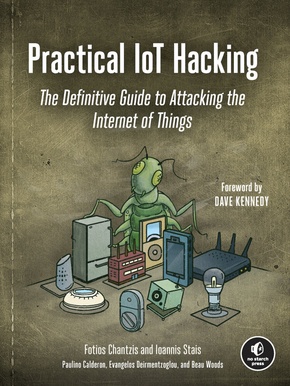Practical IoT Hacking - The Definitive Guide to Attacking the Internet of Things
| Verlag | No Starch Press |
| Auflage | 2021 |
| Seiten | 464 |
| Format | 17,9 x 3,0 x 2,9 cm |
| Gewicht | 898 g |
| Artikeltyp | Englisches Buch |
| EAN | 9781718500907 |
| Bestell-Nr | 71850090UA |
Written by all-star security experts, Practical IoT Hacking is a quick-start conceptual guide to testing and exploiting IoT systems and devices.
Drawing from the real-life exploits of five highly regarded IoT security researchers, Practical IoT Hacking teaches you how to test IoT systems, devices, and protocols to mitigate risk.
The book begins by walking you through common threats and a threat modeling framework. You ll develop a security testing methodology, discover the art of passive reconnaissance, and assess security on all layers of an IoT system. Next, you ll perform VLAN hopping, crack MQTT authentication, abuse UPnP, develop an mDNS poisoner, and craft WS-Discovery attacks.
You ll tackle both hardware hacking and radio hacking, with in-depth coverage of attacks against embedded IoT devices and RFID systems.
You ll also learn how to:
Write a DICOM service scanner as an NSE moduleHack a microcontroller through the UART and SWD interfacesRe verse engineer firmware and analyze mobile companion appsDevelop an NFC fuzzer using Proxmark3Hack a smart home by jamming wireless alarms, playing back IP camera feeds, and controlling a smart treadmill
The tools and devices you ll use are affordable and readily available, so you can easily practice what you learn. Whether you re a security researcher, IT team member, or hacking hobbyist, you ll find Practical IoT Hacking indispensable in your efforts to hack all the things
REQUIREMENTS: Basic knowledge of Linux command line, TCP/IP, and programming
Inhaltsverzeichnis:
Preface
Foreword
Part One: The IoT Threat Landscape
Chapter 1: The IoT Security World
Chapter 2: Threat Modeling
Chapter 3: A Security Testing Methodology
Part Two: Network Hacking
Chapter 4: Network Assessments
Chapter 5: Analyzing Network Protocols
Chapter 6: Exploiting Zero-configuration Networking
Part Three: Hardware Hacking
Chapter 7: UART, JTAG, and SWD Exploitation
Chapter 8: Hacking SPI and I2C
Chapter 9: Firmware Hacking
Part Four: Radio Hacking
Chapter 10: Abusing RFID
Chapter 11: Exploiting Bluetooth Low Energy
Chapter 12: Wi-Fi Hacking
Chapter 13: Exploiting LPWAN
Part Five: Targeting the IoT Ecosystem
Chapter 14: Attacking Mobile Applications
Chapter 15: Hacking the Smart Home
Appendix A: Tools for IoT Hacking

